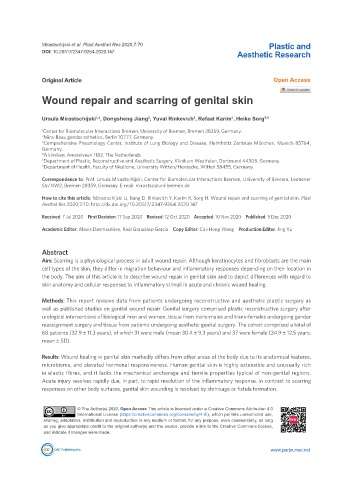Page 825 - Read Online
P. 825
Mirastschijski et al. Plast Aesthet Res 2020;7:70 Plastic and
DOI: 10.20517/2347-9264.2020.147 Aesthetic Research
Original Article Open Access
Wound repair and scarring of genital skin
Ursula Mirastschijski , Dongsheng Jiang , Yuval Rinkevich , Refaat Karim , Heiko Sorg 5,6
4
3
1,2
3
1 Center for Biomolecular Interactions Bremen, University of Bremen, Bremen 28359, Germany.
2 Mira-Beau gender esthetics, Berlin 10777, Germany.
3 Comprehensive Pneumology Center, Institute of Lung Biology and Disease, Helmholtz Zentrum München, Munich 85764,
Germany.
4 A kliniken, Amstelveen 1182, The Netherlands.
5 Department of Plastic, Reconstructive and Aesthetic Surgery, Klinikum Westfalen, Dortmund 44309, Germany.
6 Department of Health, Faculty of Medicine, University Witten/Herdecke, Witten 58455, Germany.
Correspondence to: Prof. Ursula Mirastschijski, Center for Biomolecular Interactions Bremen, University of Bremen, Leobener
Str/NW2, Bremen 28359, Germany. E-mail: mirastsc@uni-bremen.de
How to cite this article: Mirastschijski U, Jiang D, Rinkevich Y, Karim R, Sorg H. Wound repair and scarring of genital skin. Plast
Aesthet Res 2020;7:70. http://dx.doi.org/10.20517/2347-9264.2020.147
Received: 7 Jul 2020 First Decision: 17 Sep 2020 Revised: 12 Oct 2020 Accepted: 10 Nov 2020 Published: 5 Dec 2020
Academic Editor: Alexis Desmoulière, Raúl González-García Copy Editor: Cai-Hong Wang Production Editor: Jing Yu
Abstract
Aim: Scarring is a physiological process in adult wound repair. Although keratinocytes and fibroblasts are the main
cell types of the skin, they differ in migration behaviour and inflammatory responses depending on their location in
the body. The aim of this article is to describe wound repair in genital skin and to depict differences with regard to
skin anatomy and cellular responses to inflammatory stimuli in acute and chronic wound healing.
Methods: This report reviews data from patients undergoing reconstructive and aesthetic plastic surgery as
well as published studies on genital wound repair. Genital surgery comprised plastic reconstructive surgery after
urological interventions of biological men and women, tissue from trans-males and trans-females undergoing gender
reassignment surgery and tissue from patients undergoing aesthetic genital surgery. The cohort comprised a total of
68 patients (32.9 ± 11.3 years), of which 31 were male (mean 30.4 ± 9.3 years) and 37 were female (34.9 ± 12.5 years;
mean ± SD).
Results: Wound healing in genital skin markedly differs from other areas of the body due to its anatomical features,
microbiome, and elevated hormonal responsiveness. Human genital skin is highly extensible and unusually rich
in elastic fibres, and it lacks the mechanical anchorage and tensile properties typical of non-genital regions.
Acute injury resolves rapidly due, in part, to rapid resolution of the inflammatory response. In contrast to scarring
responses on other body surfaces, genital skin wounding is resolved by shrinkage or fistula formation.
© The Author(s) 2020. Open Access This article is licensed under a Creative Commons Attribution 4.0
International License (https://creativecommons.org/licenses/by/4.0/), which permits unrestricted use,
sharing, adaptation, distribution and reproduction in any medium or format, for any purpose, even commercially, as long
as you give appropriate credit to the original author(s) and the source, provide a link to the Creative Commons license,
and indicate if changes were made.
www.parjournal.net

